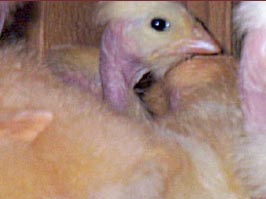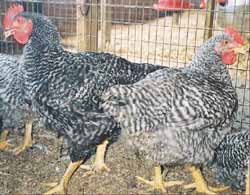



US Organic Poultry Production: Origin of Birds & Genetics
Organic Poultry Production in the United States was published by ATTRA in 2008. It discusses organic husbandry including living conditions, health, genetics and origin, feed and processing as specified under the livestock requirements of the US Department of Agriculture National Organic Program (NOP). This article covers issues regarding the origin of the birds and genetics, including a comparison of NOP standards with those in other countries.
Both pictures by Anne Fanatico, NCAT

The NOP stipulates that breeds should be chosen for their resistance to disease and their appropriateness to a site or operation.
However, in the United States, high yielding genetics are typically used in both conventional and organic poultry production.
The conventional broiler is an efficient bird that grows to market weight in seven weeks and has a high yield of breast meat. However, it may have health problems due to the fast growth. Metabolic problems include ascites (water belly) and sudden death syndrome, and leg problems include lameness. In contrast, slow-growing meat birds are used in the European Union organic programme. Although slow growing birds are less efficient meat producers, they have better livability, lower mortality rates and are more active.
In terms of egg layers, high-yielding birds lay more than 300 eggs per year but may develop osteoporosis or brittle bones. There is increasing interest in using standard breeds with historical significance, known as heritage breeds, for organic production, but heritage breeds have only been selected for egg production or exhibition for the last several decades and good utility strains for meat need to be developed.
For more information on genetics, see ATTRA's Poultry Genetics for Pastured Production.
The NOP does not require the origin of the birds to be organic. In fact, there are currently no certified organic poultry hatcheries in the United States. Non-organic chicks may be used but must be under organic management after the second day after hatching.
| Table 1. Comparison of highlights of poultry requirements regarding origin of birds and genetics of selected organic programmes | ||||||
|---|---|---|---|---|---|---|
| USDA NOP | European Union | Soil Association (UK) | Canada | National Bio-Gro (New Zealand) | IFOAM 2002 | |
| Stock | ||||||
| Origin | Under organic management after 2 days | Organic must be used if available; or under organic management after 3 days | Organic must be used if available; under organic management after 3 days accepted, must be organic for at least 10 weeks before slaughter | Under organic management after 2 days | Under organic management after 2 days | When no organic livestock is available: 2 days for meat chickens, 18 weeks for hens, 2 weeks for other poultry |
| Minimum age at slaughter | Chicken, 81 days; turkey, 140 days; duck (Peking), 49 days | Similar to EU but differs depending whether birds are organic or non-organic stock and fast or slow growing | ||||
| Genetics | Where producers do not apply these minimum slaughter ages, they must use slow-growing strains | If fast-growing genetics are used, they must be grown for 10 weeks before slaughter | ||||
March 2009








